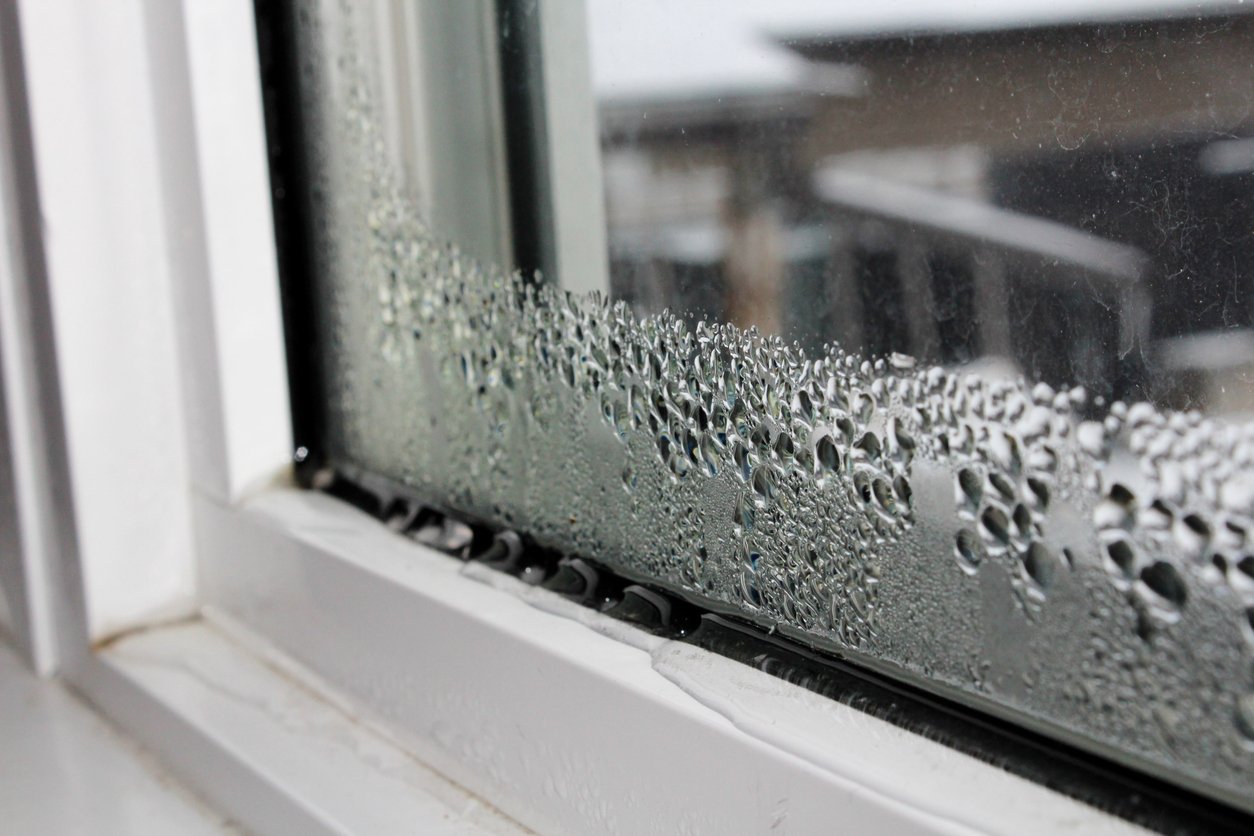Answer these simple questions and we will find you the BEST prices
Which type of solar quotes do you need?
It only takes 30 seconds
100% free with no obligation



- GreenMatch
- Blog
- Should New Windows Have Condensation
Should New Windows Have Condensation On The Inside?


Window condensation can be majorly irritating! Unfortunately, if you live in a climate with cool winters and high humidity levels, it’s pretty inevitable. As soon as you’re into autumn and the temperatures start to dip, many homeowners start seeing interior window condensation.
Although things are much better than they were a generation or so ago before double glazed windows became commonplace, condensation at bottom of double glazing is still an issue.
Though wiping windows is arduous, if you don’t deal with condensation properly and swiftly, it can have negative effects. In the most extreme of cases, window frames and window sills can grow black mould. This mould and its spores are bad for your health and can cause or exacerbate breathing problems.
In this article, we’ll talk all about why condensation forms on windows and how you can deal with it. Above all, we’ll address the question should new windows have condensation on the inside?
What is condensation?
When a vapor or gas changes state and becomes a liquid, condensation forms. This will happen when an object’s temperature (in this case, glazed windows) is lower than the dew point of the air.
The dew point is the atmospheric temperature below which water vapour will condense and form water droplets. The dew point will vary according to humidity levels and air pressure).
Since the dew point can vary, condensation can happen with higher temperatures too (when humidity is high). When it’s cold, condensation occurs even in low humidity.
What causes condensation on windows?
When the excess moisture in the air comes into contact with the cold surface of the window, it condenses and forms visible water droplets. This usually happens when there is a big difference between outside temperature and inside temperature.
The air we breathe contains many microscopic water droplets that are invisible to the naked eye. When humidity is higher, there are more of these and so you’re more likely to see condensation on your surfaces.
For example, if you have a glass of ice-cold water on a table on a hot sunny day, the outside of the glass will be wet. This is the same condensing effect we see on windows.
When the air is warmer, the molecules in it are further apart. This means the moisture is ‘held’ well. In cooler air, these molecules come closer together. When they’re close enough, they come together as a visible liquid.
Other examples of condensation we see often include:
- Condensation on the bathroom mirror after showering
- Kitchen windows ‘steamed up’ during cooking
- Condensation on windows if you’re drying your clothes inside.
Condensation will form on any surface that is cold and not just windows. It is more likely to happen if moisture is ‘trapped’. It can form on:
- a cold wall (inside fitted furniture)
- an external wall (behind furniture)
- windows with curtains or blinds closed
When is condensation more likely?
If you only have single glazed windows, condensation is more likely. This is because the temperature difference on the pane of glass is greater. Double glazed windows are more insulating and so there will be less condensation on the inside.
Before double glazing, it was common practice to clear condensation from windows each morning! In winter, you might even have been cleaning off ice!
It is still possible to see condensation on the inside of double glazing but this is much more likely if they’re older, have been damaged or the window seal has gone.
Why is condensation bad?
Ultimately, condensation is bad because it reduces a window’s lifespan. This is especially true if the sealed window unit sits in water for a long time. Condensation can also encourage mould growth, which can also damage window frames.
If a double glazed window happens to have condensation on the inside, it doesn’t mean that there is a fault or that they need replacing. It would depend entirely on the location of the condensation on the windows.
Where does condensation on double glazed windows tend to accumulate?
You’re most likely to see condensation:
- on the window’s inside pane
- on the window’s outside pane
- inside the gap between the two glass panes
Condensation on the window’s inside pane
What causes this?
In the majority of cases, condensation on the inside pane of glass happens when the room’s humidity is high and the air isn’t circulating well. In this situation, water vapour will condense onto the colder surface of the window pane. Now we’ve got such well-insulated homes with well-sealed doors, there is little air circulation, which contributes to condensation on windows.
Low internal room temperatures can also create cold surfaces in the room. This means any warm air will condense easily on them.
In bathrooms and kitchens, where moisture levels are high, condensation is more likely.
Bedroom windows might also have condensation in the morning too as the air temperature is likely to have dropped and there will be humid air from people breathing overnight without doors and windows being opened and closed.
If you have recently had any sort of construction work, you’ll have higher moisture levels for up six months potentially due to drying concrete, wet plaster, and paint. In this case, it will be harder to stop condensation.
For anyone with condensation problems, it’s important to wipe it away with a towel or cloth as soon as you can. If it sits on your surfaces, it will eventually lead to mould, rot, and damage.
The solution
The simplest and most efficient way of dealing with condensation on a window’s inside pane is to improve air circulation in the room. This will reduce the humidity and mean there is less moisture in the room.
Make sure you are frequently cleaning windows to remove any condensation or mould build up.
Keeping your home at a relatively warm and constant temperature will also reduce how cold the surfaces are and will make it more difficult for condensation to appear.
In the bathroom, you should have an extractor fan or an open window when you’re in the bath or shower (and for a while afterward too). This will remove the moisture-rich air. It will also prevent water vapour from condensing. Closing your bathroom door while showering will also protect the rest of your home from being subjected to moisture-rich air and will stop condensation in other rooms of the house.
In the kitchen, it’s a good idea to use lids on your pans to reduce condensation. Opening the windows or using the extractor fan will also remove excess moisture.
If you dry your clothes in a tumble dryer, ensure it vents to outside. If you don’t have a tumble dryer, try and line dry your clothes as often as possible as drying inside increases humidity levels. If you can’t avoid drying wet clothes inside, opening windows will help.
Alternatively, getting a dehumidifier will remove excess moisture from the air too. Dehumidifiers aren’t cheap to run but they are excellent at reducing condensation.
Finally, if your home has air bricks, don’t block these up as they were designed to help air circulate better to stop condensation.
Condensation on the window’s outside pane
What causes this?
Though condensation on the outside pane doesn’t happen often, when it does happen, it’s a good sign. Essentially, it means that the window unit is working very well and is thermally efficient.
Exterior window condensation on your double glazing isn’t a sign that something isn’t working!
The reason why you see this is because the air is warmer than the cold surface of the window surface, and the air dew point is higher. You’re more likely to see this type of condensation in the early morning or later at night when the temperatures are low. It’s also much more likely in clear skies and when there’s very little wind.
The solution
You don’t need a solution! With this type of condensation, it’s a good thing: it means your windows are being energy efficient and that they’re made from low-e glass.
The only problem it causes is poorer visibility, but this is short-lived.
If you like looking at a clear view in the morning, you might want to eradicate this. Usually, you can use shrubs and trees to shelter the window to help it retain warmth. Alternatively, you should allow more wind to flow to reduce condensation. Ultimately, though, it’s not really a problem you need to solve!
Condensation in between the two glass panes
What causes this?
There are a few reasons why condensation forms in the middle of your double-glazed window unit.
As with a lot of home installations, windows deteriorate over time. How soon this happens will depend entirely on the quality of the windows installed. Eventually, the sealed unit will degrade and let moist air into the gap between the two panes.
On sub-standard or older units, the seal might become loose eventually. This seal might just be a rubber strip. If it’s not a high-quality seal, it will deteriorate quicker, thus allowing water and moisture to get inside the panes.
If you let lots of moisture settle inside the windows for a long time, the air gap will become condensed – often all of the time. Sometimes, you might also see the uPVC crack, allowing water to gather.
Another reason for double glazing condensation is due to a fault in the ‘spacer’. This spacer is usually placed in between the glass panes and contains desiccant. The desiccant is highly-absorptive and will soak up moisture in the gap.
If the window seal has any sort of imperfection, the desiccant will quickly get saturated by water or moist air. When it is fully saturated, excessive moisture will appear inside the sealed unit as condensation.
Thus, the problem might have been there a while but will only become visible when the desiccant can’t hold onto any more moisture.
The solution
Seeing condensation on the inside of double glazed windows is both undesirable and annoying. Unfortunately, it will also mean that heat escapes from your home in this way and, therefore, your windows aren’t doing the job of insulating your home as efficiently as they should.
If you have moisture, water or condensation between the window panes, it is highly likely to be a broken seal causing it. This means, unfortunately, that the windows aren’t doing their job.
In terms solving the issue, it depends on the cause of the problem. There are two main ways this problem can be solved:
- Repairing the window
- Replacing the window.
Should you repair your windows?
If you still have good, solid uPVC frames, you might be able to fix the condensation issue by replacing the sealed unit. This is, obviously, a cheaper solution than replacing a whole window.
In the vast majority of cases, a specialist will drill a hole in the ‘spacer’ or glass unit. There will then be a desiccant or drying agent injected or pumped inside to dehumidify the air or to expel any condensation inside the sealed unit. Sometimes, the repairer will use an anti-fogging agent to help prevent further moisture from building up before the unit is then sealed again.
If you’re thinking of repairing a window rather than replacing it, you should bear in mind that a failed seal most likely caused the issue in the first place. If you reseal it, you might solve the issue, but it might not last as long.
Should you replace your windows?
Of course, replacing a window is much more expensive than repairing a sealed unit. However, it is a guaranteed solution and might just provide better value in the longer term – if you can afford it, obviously.
If condensation on windows is happening and they’re not ten years old yet, you might want to see if they are still under a guarantee. If they are, contact the installers and report it. If the window seal or the window unit is defective, they should install a new one without charge. If you’re thinking of doing this, don’t tamper with them or attempt to repair them as you could invalidate the guarantee.
Most window companies make windows to be of a very high standard. New windows usually have a ten-year guarantee. Some will even last fifteen or twenty years.
Most double-glazed windows now fitted are A-rated. These help reduce condensation and heat loss from homes. They’re also capable of locking in heat captured by the sun, thus reducing energy bills.
Final thoughts – should new windows have condensation on the inside?
To answer the question, no, new windows shouldn’t really have condensation on the inside – at least not in between the two panes. If window condensation is appearing on double glazing on the inner pane, this is normal and can be resolved with an extractor fan, open window, dehumidifier, or trickle vents on doors and windows.
If you’ve got a serious condensation problem where internal condensation issues occur daily, you could consider a whole-house ventilation system, though this isn’t cheap.

Luis Antonio is a seasoned Content Writer with international journalism experience. His writing style, enriched by a Master’s in Journalism, contributes informative content to GreenMatch on topics including low-carbon heating systems.
We strive to connect our customers with the right product and supplier. Would you like to be part of GreenMatch?





